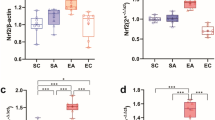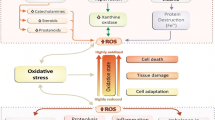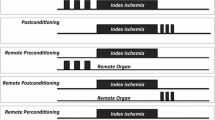Abstract
Introduction
Oxidative stress plays a pivotal role in the intense exercise-induced myocardium injury, and mitochondrial compartment is presumed as the main source and susceptible target of intracellular reactive oxygen species (ROS).
Purpose
The objective of this study was to evaluate the protective effect of quercetin, a naturally occurring flavonoids possessing antioxidant effect on repeated intense exercise-induced mitochondrial oxidative stress and dysfunction.
Methods
Adult male BALB/C mice were treated by quercetin (100 mg/kg bw) for 4 weeks and subjected to the exercise protocol on a treadmill (28 m/min at 5° slope for 90 min) for seven consecutive days concurrently at the fourth week.
Results
Intense exercise in mice resulted in the leakage of creatine kinase-MB (increased from 221.5 ± 33.8 to 151.1 ± 19.1 U/l, P < 0.01) and ultrastructural malformation mainly evidenced by disrupted myofibrils and swollen mitochondria, which was overtly attenuated by quercetin prophylaxis. Quercetin pretreatment evidently alleviated mitochondrial oxidative stress by inhibiting glutathione depletion and aconitase inactivation, ROS over-generation, and lipid peroxidation in cardiac mitochondria of intense exercise mice. Furthermore, mitochondrial dysfunction manifested by decreased mitochondrial membrane potential (68.6 ± 7.6 versus 100.0 ± 7.7 %, P < 0.01) and respiratory control ratio (5.03 ± 0.55 versus 7.48 ± 0.71, P < 0.01) induced as a consequence of acute exercise was markedly mitigated by quercetin precondition.
Conclusion
Quercetin protects mouse myocardium against intense exercise injury, especially ultrastructural damage and mitochondrial dysfunction, probably through its beneficial antioxidative effect, highlighting a promising strategy for over-training injury by naturally occurring phytochemicals.






Similar content being viewed by others
References
Ascensao AA, Magalhaes JF, Soares JM, Ferreira RM, Neuparth MJ, Appell HJ, Duarte JA (2005) Cardiac mitochondrial respiratory function and oxidative stress: the role of exercise. Int J Sports Med 26:258–267
Ascensao A, Ferreira R, Magalhaes J (2007) Exercise-induced cardioprotection—biochemical, morphological and functional evidence in whole tissue and isolated mitochondria. Int J Cardiol 117:16–30
Bejma J, Ji LL (1999) Aging and acute exercise enhance free radical generation in rat skeletal muscle. J Appl Physiol 87:465–470
Bischoff SC (2008) Quercetin: potentials in the prevention and therapy of disease. Curr Opin Clin Nutr Metab Care 11:733–740
Bo H, Jiang N, Ma G, Qu J, Zhang G, Cao D, Wen L, Liu S, Ji LL, Zhang Y (2008) Regulation of mitochondrial uncoupling respiration during exercise in rat heart: role of reactive oxygen species (ROS) and uncoupling protein 2. Free Radic Bio Med 44:1373–1381
Boots AW, Haenen GR, Bast A (2008) Health effects of quercetin: from antioxidant to nutraceutical. Eur J Pharmacol 585:325–337
Brookes PS, Digerness SB, Parks DA, Darley-Usmar V (2002) Mitochondrial function in response to cardiac ischemia-reperfusion after oral treatment with quercetin. Free Radic Biol Med 32:1220–1228
Buege JA, Aust SD (1978) Microsomal lipid peroxidation. Methods Enzymol 52:302–310
Carrasco-Pozo C, Mizgier ML, Speisky H, Gotteland M (2012) Differential protective effects of quercetin, resveratrol, rutin and epigallocatechin gallate against mitochondrial dysfunction induced by indomethacin in Caco-2 cells. Chem Biol Interact 195:199–205
Cureton KJ, Tomporowski PD, Singhal A, Pasley JD, Bigelman KA, Lambourne K, Trilk JL, McCully KK, Arnaud MJ, Zhao Q (2009) Dietary quercetin supplementation is not ergogenic in untrained men. J Appl Physiol 107:1095–1104
Davis JM, Murphy EA, Carmichael MD, Davis B (2009) Quercetin increases brain and muscle mitochondrial biogenesis and exercise tolerance. Am J Physiol Regul Integr Comp Physiol 296:R1071–R1077
Davis JM, Carlstedt CJ, Chen S, Carmichael MD, Murphy EA (2010) The dietary flavonoid quercetin increases VO(2max) and endurance capacity. Int J Sport Nutr Exerc Metab 20:56–62
Dorta DJ, Pigoso AA, Mingatto FE, Rodrigues T, Prado IM, Helena AF, Uyemura SA, Santos AC, Curti C (2005) The interaction of flavonoids with mitochondria: effects on energetic processes. Chem Biol Interact 152:67–78
Dorta DJ, Pigoso AA, Mingatto FE, Rodrigues T, Pestana CR, Uyemura SA, Santos AC, Curti C (2008) Antioxidant activity of flavonoids in isolated mitochondria. Phytother Res 22:1213–1218
Emaus RK, Grunwald R, Lemasters JJ (1986) Rhodamine 123 as a probe of transmembrane potential in isolated rat-liver mitochondria: spectral and metabolic properties. Biochim Biophys Acta 850:436
Fiorani M, Guidarelli A, Blasa M, Azzolini C, Candiracci M, Piatti E, Cantoni O (2010) Mitochondria accumulate large amounts of quercetin: prevention of mitochondrial damage and release upon oxidation of the extramitochondrial fraction of the flavonoid. J Nutr Biochem 21:397–404
Freiberger JJ, Suliman HB, Sheng H, McAdoo J, Piantadosi CA, Warner DS (2006) A comparison of hyperbaric oxygen versus hypoxic cerebral preconditioning in neonatal rats. Brain Res 1075:213–222
Hayward R, Balog JM, Schneider CM (1998) Response of serum indicators of myocardial infarction following exercise-induced muscle injury. Am J Emerg Med 16:107–113
Kressler J, Millard-Stafford M, Warren GL (2011) Quercetin and endurance exercise capacity: a systematic review and meta-analysis. Med Sci Sports Exerc 43:2396–2404
Lagoa R, Graziani I, Lopez-Sanchez C, Garcia-Martinez V, Gutierrez-Merino C (2011) Complex I and cytochrome c are molecular targets of flavonoids that inhibit hydrogen peroxide production by mitochondria. Biochim Biophys Acta 1807:1562–1572
Latchoumycandane C, Chitra KC, Mathur PP (2002) The effect of 2,3,7,8-tetrachlorodibenzo-p-dioxin on the antioxidant system in mitochondrial and microsomal fractions of rat testis. Toxicology 171:127–135
Lowry OH, Rosebrough NJ, Farr AL, Randall RJ (1951) Protein measurement with the Folin phenol reagent. J Biol Chem 193:265–275
Marra S, Burnett M, Hoffman-Goetz L (2005) Intravenous catecholamine administration affects mouse intestinal lymphocyte number and apoptosis. J Neuroimmunol 158:76–85
McAnulty SR, McAnulty LS, Nieman DC, Quindry JC, Hosick PA, Hudson MH, Still L, Henson DA, Milne GL, Morrow JD, Dumke CL, Utter AC, Triplett NT, Dibarnardi A (2008) Chronic quercetin ingestion and exercise-induced oxidative damage and inflammation. Appl Physiol Nutr Metab 33:254–262
Moron MS, Depierre JW, Mannervik B (1979) Levels of glutathione, glutathione reductase and glutathione S-transferase activities in rat lung and liver. Biochim Biophys Acta 582:67–78
Neilan TG, Januzzi JL, Lee-Lewandrowski E, Ton-Nu TT, Yoerger DM, Jassal DS, Lewandrowski KB, Siegel AJ, Marshall JE, Douglas PS, Lawlor D, Picard MH, Wood MJ (2006) Myocardial injury and ventricular dysfunction related to training levels among nonelite participants in the Boston marathon. Circulation 114:2325–2333
Nie J, Close G, George KP, Tong TK, Shi Q (2010) Temporal association of elevations in serum cardiac troponin T and myocardial oxidative stress after prolonged exercise in rats. Eur J Appl Physiol 110:1299–1303
Nieman DC, Williams AS, Shanely RA, Jin F, McAnulty SR, Triplett NT, Austin MD, Henson DA (2010) Quercetin’s influence on exercise performance and muscle mitochondrial biogenesis. Med Sci Sports Exerc 42:338–345
Onori P, Morini S, Franchitto A, Sferra R, Alvaro D, Gaudio E (2000) Hepatic microvascular features in experimental cirrhosis: a structural and morphometrical study in CCl4-treated rats. J Hepatol 33:555–563
Perez AC, Cabral DOA, Estevez E, Molina AJ, Prieto JG, Alvarez AI (2003) Mitochondrial, sarcoplasmic membrane integrity and protein degradation in heart and skeletal muscle in exercised rats. Comp Biochem Physiol C Toxicol Pharmacol 134:199–206
Powers SK, Jackson MJ (2008) Exercise-induced oxidative stress: cellular mechanisms and impact on muscle force production. Physiol Rev 88:1243–1276
Powers SK, Quindry JC, Kavazis AN (2008) Exercise-induced cardioprotection against myocardial ischemia-reperfusion injury. Free Radic Biol Med 44:193–201
Powers SK, Nelson WB, Hudson MB (2011) Exercise-induced oxidative stress in humans: cause and consequences. Free Radic Biol Med 51:942–950
Punithavathi VR, Stanely MPP (2010) Protective effects of combination of quercetin and alpha-tocopherol on mitochondrial dysfunction and myocardial infarct size in isoproterenol-treated myocardial infarcted rats: biochemical, transmission electron microscopic, and macroscopic enzyme mapping evidences. J Biochem Mol Toxicol 24:303–312
Saborido A, Naudi A, Portero-Otin M, Pamplona R, Megias A (2011) Stanozolol treatment decreases the mitochondrial ROS generation and oxidative stress induced by acute exercise in rat skeletal muscle. J Appl Physiol 110:661–669
Sachdev S, Davies KJ (2008) Production, detection, and adaptive responses to free radicals in exercise. Free Radic Biol Med 44:215–223
Santos AC, Uyemura SA, Lopes JL, Bazon JN, Mingatto FE, Curti C (1998) Effect of naturally occurring flavonoids on lipid peroxidation and membrane permeability transition in mitochondria. Free Radic Biol Med 24:1455–1461
Schoepe M, Schrepper A, Schwarzer M, Osterholt M, Doenst T (2012) Exercise can induce temporary mitochondrial and contractile dysfunction linked to impaired respiratory chain complex activity. Metabolism 61:117–126
Somani SM, Frank S, Rybak LP (1995) Responses of antioxidant system to acute and trained exercise in rat heart subcellular fractions. Pharmacol Biochem Be 51:627–634
Starnes JW, Taylor RP (2007) Exercise-induced cardioprotection: endogenous mechanisms. Med Sci Sports Exerc 39:1537–1543
Tang Y, Gao C, Xing M, Li Y, Zhu L, Wang D, Yang X, Liu L, Yao P (2012) Quercetin prevents ethanol-induced dyslipidemia and mitochondrial oxidative damage. Food Chem Toxicol 50:1194–1200
Wang L, Zhang HL, Lu R, Zhou YJ, Ma R, Lv JQ, Li XL, Chen LJ, Yao Z (2008) The decapeptide CMS001 enhances swimming endurance in mice. Peptides 29:1176–1182
Yu F, Lu S, Feng S, McGuire PM, Li R, Wang R (2006) Protective effects of polysaccharide from Euphorbia kansui (Euphorbiaceae) on the swimming exercise-induced oxidative stress in mice. Can J Physiol Pharmacol 84:1071–1079
Acknowledgments
This work was supported by the National Natural Science Foundation of China (No. 81172658), Program for New Century Excellent Talents in University of China (NCET 08-0222), Wuhan Planning Project of Science and Technology (No. 201260523192), and Graduates’ Innovation Fund of Huazhong University of Science and Technology (HF-11-24-2013).
Conflict of interest
The authors declare that they have no conflict of interest.
Author information
Authors and Affiliations
Corresponding author
Additional information
Communicated by Fabio Fischetti.
C. Gao and X. Chen contributed equally to this work.
Rights and permissions
About this article
Cite this article
Gao, C., Chen, X., Li, J. et al. Myocardial mitochondrial oxidative stress and dysfunction in intense exercise: regulatory effects of quercetin. Eur J Appl Physiol 114, 695–705 (2014). https://doi.org/10.1007/s00421-013-2802-9
Received:
Accepted:
Published:
Issue Date:
DOI: https://doi.org/10.1007/s00421-013-2802-9




